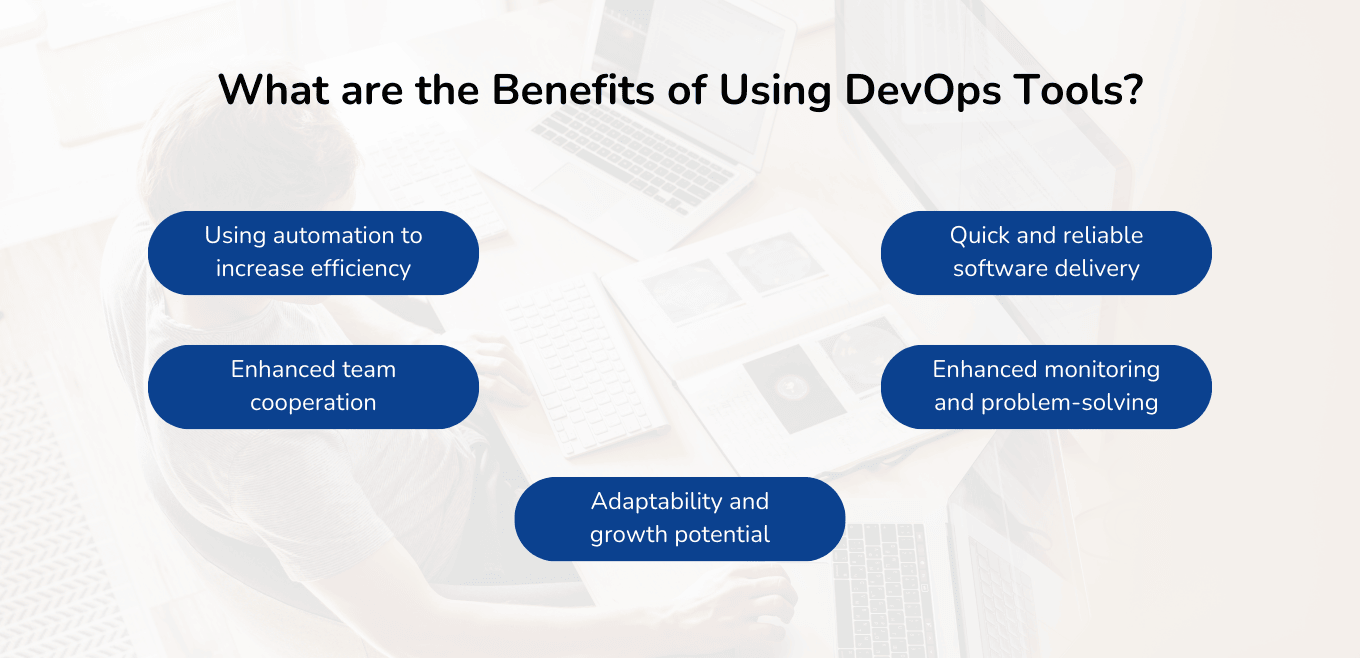DevOps aims to reduce the Systems Development Life Cycle (SDLC) and guarantee continuous delivery of high-quality software by integrating software development and IT operations.
Its main goals are to increase development speed and scalability, automate as many software development processes as feasible, and release software frequently. According to statistics, 68% of businesses report that using DevOps techniques improves the quality of their software development. At a compound annual growth rate of 18.95%, it is estimated to reach USD 12,215.54 million by 2026.
DevOps is therefore essential whether you want to automate the processes of testing, creating, or delivering a project. Even though there are many advantages to combining development and operations, choosing the right technology to help your team apply DevOps techniques can be difficult.
This blog will provide you with the top-notch DevOps tools to help your team produce software more quickly and effectively in this growing tech industry.
What are the Benefits of Using DevOps Tools?

There are many benefits to using the best DevOps technologies, especially in the current software development environment where dependability and speed are essential. These solutions are designed to improve software development lifecycle processes by offering measurable automation, efficiency, and teamwork improvements.
1. Using automation to increase efficiency
Test automation tools are essential to DevOps because they allow development and operations teams to save time by doing away with manual processes like code management, testing, deployment, and monitoring.
Jenkins and Ansible are powerful technologies that automate repetitive processes, speed up code deployment, lower the rate of human error, and cut the time it takes for software updates to be released. Artificial intelligence (AI)-driven DevOps solutions are taking on increasingly sophisticated responsibilities, such as system monitoring, failure prediction, and corrective automation.
2. Enhanced team cooperation
DevOps encourages collaboration between development and operations teams; silos can be broken down with the right tools.
Teams can easily plan, track, and communicate thanks to the combined environments provided by GitLab, Jira, and Microsoft Teams. This promotes accountability and transparency, which enhances information flow and facilitates prompt problem-solving and feedback implementation.
3. Quick and reliable software delivery
Organizations can expedite code integration, testing, and deployment across many environments by utilizing continuous integration and continuous deployment (CI/CD) platforms like CircleCI, GitHub Actions, and Jenkins.
This ensures consistent and dependable releases while reducing the time between development and deployment. Additionally, teams can deploy infrastructure with increased efficiency by utilizing Infrastructure as Code (IaC) tools like Terraform.
4. Enhanced monitoring and problem-solving
Real-time monitoring and logging capabilities provided by DevOps technologies such as Prometheus, Datadog, and Splunk enable teams to proactively identify and resolve problems. By actively monitoring system health and application performance, these technologies ensure that problems are fixed before they have an impact on the end-user experience.
5. Adaptability and growth potential
Tools like Kubernetes and Docker enable enterprises to scale their applications with exceptional efficiency as contemporary apps grow more sophisticated.
By ensuring that the system is flexible enough to handle varying workloads, these orchestration solutions streamline not just the administration of applications across various environments but also the project management procedure as a whole.
Effective DevOps Tools to Watch Out in 2025


The DevOps tools covered in this guide are grouped into the following categories to help you streamline your workflows effectively:
Infrastructure as Code (IaC) Tools
Instead of depending on manual procedures, Infrastructure as Code (IaC) uses machine-readable configuration files to manage and provision computing infrastructure. By streamlining infrastructure activities, this approach guarantees consistency and ease of replication. IaC reduces human error while enabling development and operations teams to define, deploy, and maintain infrastructure at scale with ease.
Key IaC Tools
1. Terraform
HashiCorp developed Terraform, an open-source IaC tool that is compatible with several platforms. Using a declarative language enables teams to describe infrastructure across several cloud providers, such as AWS, Azure, and Google Cloud.
Its capacity to oversee several cloud settings and the strong backing of its large community are its main assets. DevOps teams use Terraform because of its agentless architecture, modular design, and efficient state management.
2. Ansible
Another popular IaC tool that stands out for its ease of use is Ansible. Playbooks for automating infrastructure provisioning and setup are typically created using YAML.
Because of its great adaptability, Ansible can be utilized in a variety of settings, including on-premise servers and cloud resources. It is a favored solution for automating repetitive infrastructure operations because of its large module library and robust community.
3. CloudFormation on AWS
An IaC tool designed for AWS infrastructure management is called AWS CloudFormation. It is an excellent choice for teams that are heavily involved with AWS since it uses JSON or YAML templates to describe and simplify the provisioning of AWS resources. CloudFormation provides versioning and rollback capabilities along with smooth connectivity with AWS services.
4. Puppet
Puppet functions as both an IaC platform and a configuration management tool. Whether on-premises or in the cloud, teams may efficiently use resources by clearly and systematically defining infrastructure.
Although Puppet has a steeper learning curve than other technologies like Ansible, it is nonetheless a strong tool. This can be a significant consideration for groups with little funding.
DevOps Orchestration and Containerization Tools
The practice of packaging software and its dependencies into standardized pieces called containers that can function flawlessly in a variety of computing environments is called containerization.
Because containers share the host system’s kernel, they provide a lighter alternative to conventional virtual machines. This approach improves resource efficiency and speeds up starting times.
The portability of containerization is one of its main advantages; developers may package apps with their dependencies to guarantee consistent performance on any system.
Here are a few popular containerization tools:
1. Docker
The most popular containerization platform is called Docker. It simplifies the process of packaging apps and their dependencies into containers, allowing for easy distribution and consistent performance in a range of settings. Docker is notable for its extensive tool ecosystem, strong support for CI/CD pipelines, and ease of use.
2. Podman
An open-source substitute for Docker that operates without a background daemon is called Podman. For developers that appreciate simplicity and security, this provides a lightweight and safe option. PodMan minimizes potential security issues by running rootless and integrating smoothly with Kubernetes.
Container Orchestration
It is no longer possible to manage these containers by hand when applications grow in complexity and scope. In distributed systems, container orchestration solutions are essential for managing multiple containers and simplifying processes like networking, scaling, and deployment.
The primary orchestration solution, Kubernetes, is renowned for its capacity to manage complex, large-scale container systems by automating service discovery, deployment, and scaling over numerous clusters. Conversely, Docker Swarm is a great substitute for smaller applications because it is easy to set up and blends in perfectly with Docker’s environment.
1. Kubernetes
Of course, the most popular container orchestration platform is Kubernetes, sometimes referred to as K8s. It is a crucial tool for contemporary cloud-native development since it simplifies the deployment, scaling, and maintenance of containerized applications.
While Kubernetes manages the intricacies of container orchestration, such as load balancing, self-healing, and automatic rollouts, developers can concentrate on creating code. Organizations implementing microservices architectures choose Kubernetes because of its wide ecosystem and strong community support.
2. Docker Swarm
The native clustering solution from Docker, called Docker Swarm, was created to make orchestrating containerized apps easier. It simplifies the deployment and scaling of applications over numerous nodes by converting a pool of Docker hosts into a single virtual host.
Docker Swarm is a great option for smaller teams or simpler applications that don’t need sophisticated orchestration tools, even though it lacks some of the characteristics of Kubernetes. For developers who are currently utilizing the Docker environment, its smooth interaction with Docker makes it an obvious choice. Compared to K8s, it has a far simpler learning curve.
DevOps Continuous Integration and Continuous Delivery (CI/CD) Tools
Through automation, the techniques of Continuous Integration (CI) and Continuous Delivery (CD) improve and streamline software development processes. CI emphasizes the routine integration of code updates into a common repository, together with automated testing to spot issues early. By automating the release process, CD improves this by enabling the reliable deployment of bug fixes and new features to production environments at any time.
Popular CI/CD Tools:
1. Jenkins
One of the most popular open-source CI/CD tools is Jenkins. It offers a vibrant ecosystem with over 1,000 plugins for automating DevOps pipelines and connecting various technologies with ease. Jenkins has a more difficult learning curve but enables a high degree of customization.
2. GitLab CI/CD
This tool, which is integrated with GitLab, offers smooth CI/CD capabilities, especially for repositories hosted by GitLab. The Auto DevOps feature simplifies pipeline setup and offers strong support for Kubernetes-based container orchestration. However, GitLab CI/CD could need a lot of resources for large-scale projects.
3. Travis CI
Another popular tool, especially for open-source projects, is Travis CI. It supports a large number of programming languages, is easy to set up, and connects with GitHub flawlessly. However, the free version may operate less quickly for more complex builds and offers less control over build environments.
DevOps Monitoring and Observability Tools
Although they have different functions, monitoring, and observability are essential elements of every DevOps strategy. To identify any system performance problems, monitoring focuses on tracking particular metrics like CPU utilization, memory, and network traffic.
Setting up alerts to notify teams of irregularities is part of it. Observability is a more comprehensive concept that goes beyond traditional monitoring and provides a deeper understanding of system behavior.
Common Tools for Observability and Monitoring:
1. Prometheus
One particularly well-liked open-source monitoring tool designed for cloud-native settings is Prometheus. With integrated alerting via AlertManager, it excels at collecting and storing time-series data, particularly from Kubernetes clusters. One of the most popular solutions among DevOps teams looking for strong metric collection and monitoring.
2. Grafana
Grafana is usually used for data visualization, while Prometheus is in charge of data collecting. It facilitates the exploration and analysis of system metrics by integrating with Prometheus and other data sources to produce customizable dashboards. Grafana is frequently used by teams to create visual insights in real-time and set up automated alerts for performance problems.
3. Jaeger
In microservice contexts, Jaeger is an open-source tool for distributed tracing, which is crucial for monitoring requests across several services. DevOps teams can find possible areas for optimization and identify latency concerns by using Jaeger to visualize the requests’ journey.
Conclusion
Building scalable, dependable, and effective systems requires proper infrastructure management and DevOps approaches. From improved observability with Prometheus and Grafana to infrastructure automation with People10, the tools featured in this article address different facets of the DevOps lifecycle. While not every team will benefit from every tool, knowing what each one can do can help you choose the ones that best suit your unique problems and objectives.
You may improve cooperation, streamline procedures, and get beyond typical DevOps obstacles by incorporating the appropriate set of technologies into your workflow. To improve your infrastructure management and spur creativity within your company, start by identifying any holes in your current procedures and investigate these tools.
Looking to Implement DevOps the Right Way?
We offer the best DevOps practices and tools to help you scale your software development with efficiency, reliability, and speed.
Author
Kamal Chauhan excels in DevOps and automation, focusing on infrastructure and application deployment solutions. He designs and implements automated deployment pipelines for diverse applications and sectors.




